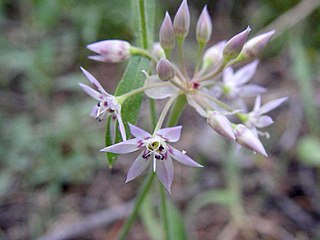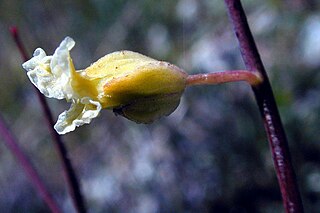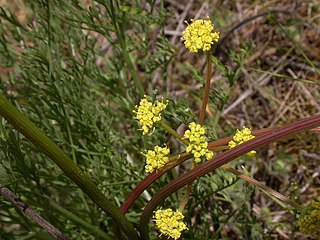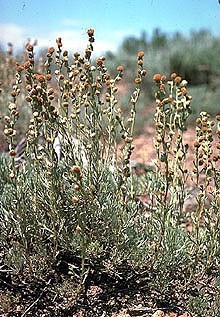
Allium campanulatum is a species of wild onion known by the common name dusky onion or Sierra onion. This is a flowering plant native to the western United States from southeastern Washington and northern Oregon to southern California, and western Nevada. The dusky onion grows in foothills and mountains, especially in dry areas, such as chaparral habitats.
Linanthus orcuttii is an uncommon species of flowering plant in the phlox family known by the common name Orcutt's linanthus. It is known only from southern California and Baja California, where it grows in chaparral and pine forests in the Peninsular Ranges and occasionally the San Bernardino Mountains.

Lomatium mohavense is a species of flowering plant in the carrot family known by the common name Mojave desertparsley. It is native to southern California with a few outlying populations in Arizona, Nevada and Baja California. It is found in several types of mountain and desert habitat, including chaparral, woodland, and scrub, mostly from 2,000–7,000 feet (600–2,100 m) elevation.
Lomatium shevockii is a rare species of flowering plant in the carrot family known by the common name Owens Peak desertparsley, or Owens Peak lomatium. It is endemic to Kern County, California, where it is known from only two occurrences at Owens Peak, one of the highest points of the Sierra Nevada. It is a plant of the talus and wooded slopes of the high mountains. This species was discovered in 1984 and first described to science in 1988.

Navarretia fossalis is a rare species of flowering plant in the phlox family known by the common name spreading navarretia.
Navarretia setiloba is a rare species of flowering plant in the phlox family known by the common names Paiute Mountain pincushionplant and Piute Mountains navarretia.

Polemonium chartaceum is a rare species of flowering plant in the phlox family known by the common names Mason's Jacob's-ladder and Mason's sky pilot. It is native to California, where it has a disjunct distribution. It occurs in the Klamath Mountains as well as the ranges east of the Sierra Nevada, including the White Mountains, where its distribution extends just into Nevada. It is a plant of high elevations, growing in exposed, rocky mountain slope habitat such as talus and alpine fellfields.

Streptanthus glandulosus is a species of flowering plant in the mustard family known by the common name bristly jewelflower. It is native to California and southwestern Oregon, where it grows in many types of habitat, including grassland, chaparral, and woodlands. Genetic and other analyses indicate that it is a species complex with ten subspecies which evolved as populations were isolated from each other. The complex includes subspecies previously considered separate species, such as the rare Tiburon jewelflower endemic to the San Francisco Bay Area. Plants in the complex are variable. In general they are annual herbs growing 10 centimeters to over a meter in height. They may be hairless to hairy to bristly. The ephemeral basal leaves have blades borne on winged petioles. Leaves higher on the stem are linear to lance-shaped and clasp the stem at their bases. Flowers occur at intervals along the upper stem. Each flower has an urn-shaped calyx of sepals one half to over one centimeter long which can be most any color from white to yellowish to pink or purple to nearly black. Purple, white, or purple-veined white petals emerge from the tip. The fruit is a straight or curving silique up to 11 centimeters long.

Lomatium observatorium is a rare species of flowering plant in the carrot family known by the common names Mt. Hamilton desertparsley and Mount Hamilton lomatium. It is endemic to California, where it is known only from the mountains of Santa Clara County, including Mount Hamilton near the Lick Observatory. It may also occur in Stanislaus County. Its habitat includes mountain woodlands on volcanic and metamorphosed sedimentary rock substrates. Described The plant to science as a new species in 1996, the plant is a perennial herb growing low to the ground, the lightly hairy herbage growing from a long taproot.
Navarretia ojaiensis is a rare species of flowering plant in the phlox family known by the common name Ojai navarretia.
Saltugilia latimeri is an uncommon species of flowering plant in the phlox family known by the common name Latimer's woodland gilia. It is endemic to California, where it is known from several scattered occurrences in the western Mojave Desert and outlying areas to the north. It occurs in dry rocky and sandy desert canyons. It was first described as a species in 2001.

Lomatium cookii is a rare species of flowering plant in the carrot family known by the common names Cook's lomatium and agate desertparsley. It is endemic to Oregon in the United States, where it grows in only two valleys. It is a federally listed endangered species.

Lomatium greenmanii is a rare species of flowering plant in the carrot family known by the common names Greenman's desertparsley and Greenman's biscuitroot. It is endemic to Oregon in the United States, where it is found only in the Wallowa Mountains of Wallowa County.

Lomatium ochocense is a rare species of flowering plant in the carrot family known by the common name Ochoco lomatium. It is endemic to Oregon, where it is limited to the Ochoco Mountains of Crook County.
Aliciella sedifolia is a rare species of flowering plant in the phlox family known by the common name stonecrop gilia. It is endemic to Colorado in the United States, where it is limited to a small area in the San Juan Mountains.

Artemisia papposa is a species of flowering plant in the aster family known by the common names Owyhee sage, Owyhee sagebrush, and fuzzy sagebrush. It is native to the Snake River Plain and surrounding areas in the northwestern United States, occurring in southern Idaho, eastern Oregon, and northern Nevada.

Linanthus pungens is a species of flowering plant in the phlox family known by the common names granite prickly-phlox and granite gilia. It is native to western North America from British Columbia to Baja California and east to Montana and New Mexico.
Astragalus anisus is a species of flowering plant in the legume family known by the common name Gunnison milkvetch. It is endemic to Colorado in the United States, where it is limited to the Gunnison Basin of Gunnison and Saguache Counties.
Physaria fremontii is a species of flowering plant in the family Brassicaceae known by the common name Fremont's bladderpod. It is endemic to Wyoming in the United States, where it occurs only in and around the Wind River Range in Fremont County.

Saltugilia is a genus of flowering plants in the phlox family, Polemoniaceae. They are known commonly as woodland gilias. There are four species. Two are endemic to California in the United States, and the distributions of the other two extend into Baja California in Mexico.













